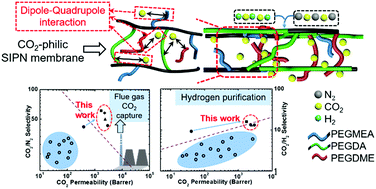Pushing CO2-philic membrane performance to the limit by designing semi-interpenetrating networks (SIPN) for sustainable CO2 separations†
Abstract
Semi-interpenetrating network (SIPN) membranes with unprecedentedly high CO2 permeability were designed and synthesized simply through one-step, UV-induced radical polymerization. The in situ embedment of linear polyethylene glycol as a “CO2 transport promoter” in membranes can dramatically enhance both CO2 solubility and diffusivity to push SIPN membrane performance beyond Robeson's upper bound line (2008). This extremely facile performance-manipulating strategy establishes our CO2-philic SIPN membranes as an exciting platform for sustainable CO2 separations.



 Please wait while we load your content...
Please wait while we load your content...